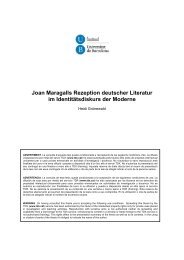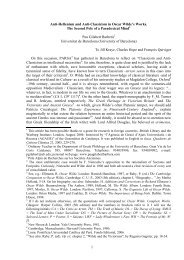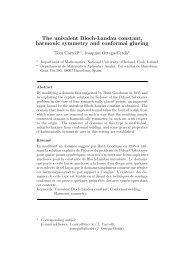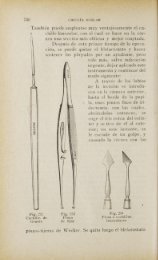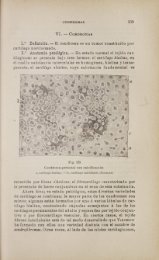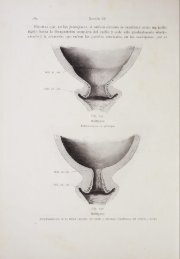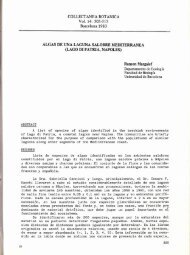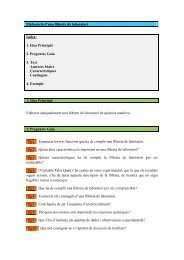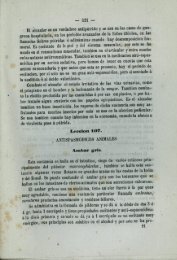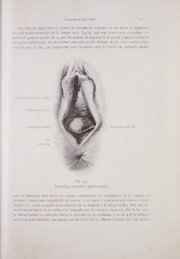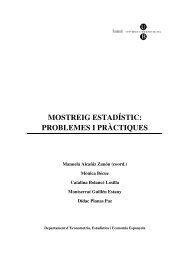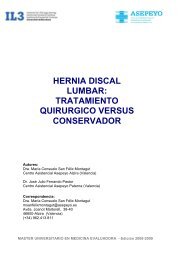Structure of 60° dislocations at the GaAs/Si interface - Universitat de ...
Structure of 60° dislocations at the GaAs/Si interface - Universitat de ...
Structure of 60° dislocations at the GaAs/Si interface - Universitat de ...
You also want an ePaper? Increase the reach of your titles
YUMPU automatically turns print PDFs into web optimized ePapers that Google loves.
<strong>Structure</strong> <strong>of</strong> <strong>60°</strong> <strong>disloc<strong>at</strong>ions</strong> <strong>at</strong> <strong>the</strong> <strong>GaAs</strong>/<strong>Si</strong> <strong>interface</strong><br />
A. Vilà, A. Cornet, and J. R. Morante<br />
LCMM, Dept. Física Aplicada i Electrònica, Universit<strong>at</strong> <strong>de</strong> Barcelona, Diagonal 645-647,<br />
08028 Barcelona, Spain<br />
P. Ruterana<br />
LERMAT, Université <strong>de</strong> Caen, 6 Bld Maréchal Juin, 14050 Caen, France<br />
M. Loubradou and R. Bonnet<br />
Institut N<strong>at</strong>ional Polytéchnique, LTPCM, ENSEEG, Domaine Universitaire, BP 44, 38401 Saint Martin<br />
D’Hères, France<br />
Received 3 January 1995; accepted for public<strong>at</strong>ion 12 October 1995<br />
High-resolution electron microscopy technique has been applied to a <strong>de</strong>tailed study <strong>of</strong> <strong>the</strong> <strong>60°</strong><br />
<strong>disloc<strong>at</strong>ions</strong> <strong>at</strong> <strong>the</strong> <strong>at</strong>omic layer molecular-beam-epitaxial <strong>GaAs</strong>/<strong>Si</strong> <strong>interface</strong>. Their <strong>de</strong>form<strong>at</strong>ion<br />
fields strongly interact with neighbor <strong>disloc<strong>at</strong>ions</strong> inducing irregular spacing between <strong>the</strong> cores and<br />
possible dissoci<strong>at</strong>ions. Bi<strong>at</strong>omic silicon steps were observed <strong>at</strong> <strong>the</strong> <strong>interface</strong>, but never insi<strong>de</strong> <strong>60°</strong><br />
disloc<strong>at</strong>ion cores. Computer image simul<strong>at</strong>ion and elasticity calcul<strong>at</strong>ions <strong>of</strong> <strong>the</strong> <strong>at</strong>omic displacement<br />
field have been used in or<strong>de</strong>r to <strong>de</strong>termine <strong>the</strong> structure <strong>of</strong> <strong>the</strong> <strong>60°</strong> disloc<strong>at</strong>ion; however, due to <strong>the</strong><br />
Eshelby effect and to interaction with some neighbor <strong>disloc<strong>at</strong>ions</strong>, in many cases no <strong>the</strong>oretical<br />
mo<strong>de</strong>l could explain some observ<strong>at</strong>ions. © 1996 American Institute <strong>of</strong> Physics.<br />
S0021-89799606302-2<br />
I. INTRODUCTION<br />
For a number <strong>of</strong> years, <strong>the</strong>re has been high activity in <strong>the</strong><br />
molecular-beam-epitaxy MBE growth <strong>of</strong> <strong>GaAs</strong> on <strong>Si</strong> substr<strong>at</strong>es<br />
mainly for <strong>the</strong> high-quality, low-cost, high <strong>the</strong>rmal<br />
conductivity, and mechanical strength <strong>of</strong> <strong>the</strong> <strong>Si</strong> substr<strong>at</strong>es, as<br />
well as for <strong>the</strong> direct visible gap and high mobility <strong>of</strong> <strong>GaAs</strong>.<br />
Eventually, <strong>the</strong> aim is to combine <strong>the</strong> optoelectronical properties<br />
<strong>of</strong> <strong>GaAs</strong> and <strong>the</strong> well <strong>de</strong>veloped technology on silicon,<br />
i.e., monolithic integr<strong>at</strong>ion <strong>of</strong> <strong>GaAs</strong> and <strong>Si</strong> technology.<br />
The growth <strong>of</strong> high-quality <strong>GaAs</strong> on <strong>Si</strong> has for a long<br />
time confronted three major problems: <strong>the</strong> 4% l<strong>at</strong>tice mism<strong>at</strong>ch<br />
between <strong>the</strong> two m<strong>at</strong>erials, <strong>the</strong> 60% difference in <strong>the</strong><br />
<strong>the</strong>rmal-expansion coefficient, and <strong>the</strong> form<strong>at</strong>ion <strong>of</strong> inversion<br />
domains in <strong>the</strong> polar epitaxial layer. The n<strong>at</strong>ure <strong>of</strong> <strong>the</strong> <strong>de</strong>fects<br />
th<strong>at</strong> nucle<strong>at</strong>e <strong>at</strong> <strong>the</strong> <strong>interface</strong> plays a crucial role in <strong>the</strong> <strong>GaAs</strong><br />
layer structure and final properties. These <strong>de</strong>fects can be<br />
Lomer and <strong>60°</strong> <strong>disloc<strong>at</strong>ions</strong>, as well as stacking faults and<br />
inversion boundaries and, as growth occurs in a threedimensional<br />
mo<strong>de</strong>, grain boundaries can also form. Among<br />
<strong>the</strong>se <strong>de</strong>fects, <strong>the</strong> <strong>60°</strong> disloc<strong>at</strong>ion has a very peculiar role in<br />
<strong>the</strong> <strong>de</strong>grad<strong>at</strong>ion <strong>of</strong> <strong>the</strong> properties <strong>of</strong> <strong>the</strong> <strong>GaAs</strong> layer. This type<br />
<strong>of</strong> disloc<strong>at</strong>ion has its Burgers vector and disloc<strong>at</strong>ion line<br />
along 111 crystallographic planes <strong>of</strong> easy slip in <strong>GaAs</strong>, so<br />
<strong>the</strong>y can easily move up through <strong>the</strong> layer and thread toward<br />
<strong>the</strong> surface. 1 The threading lines can cause enhanced impurity<br />
diffusion, partial short circuits for p-n junctions, and <strong>the</strong><br />
<strong>de</strong>grad<strong>at</strong>ion <strong>of</strong> optical and electrical properties <strong>of</strong> <strong>the</strong> epilayers.<br />
At <strong>the</strong> point view <strong>of</strong> structure, a large number <strong>of</strong> results<br />
exists on <strong>the</strong> study <strong>of</strong> <strong>the</strong> <strong>60°</strong> disloc<strong>at</strong>ion in bulk m<strong>at</strong>erials.<br />
Most <strong>of</strong> <strong>the</strong>m are based on <strong>the</strong> mo<strong>de</strong>l proposed by Shockley<br />
in 1953 2 for diamond m<strong>at</strong>erials, whose <strong>de</strong>tailed structure was<br />
sketched and used to <strong>de</strong>scribe <strong>the</strong> core and jogs <strong>of</strong> <strong>the</strong> o<strong>the</strong>r<br />
disloc<strong>at</strong>ion types possible in diamond l<strong>at</strong>tice by Hornstra. 3<br />
However, a quite general conclusion can be th<strong>at</strong> un<strong>de</strong>r stress<br />
it always <strong>de</strong>composes into its 90° and 30° partials giving rise<br />
to a stacking fault in between. The two partials can be more<br />
or less wi<strong>de</strong>ly spaced. 4–6 Especially in <strong>GaAs</strong> <strong>the</strong> 30° partial<br />
has been recently studied using high-resolution transmission<br />
electron microscopy HREM. 7 It was also shown th<strong>at</strong> <strong>the</strong><br />
<strong>60°</strong> disloc<strong>at</strong>ion can particip<strong>at</strong>e in <strong>the</strong> form<strong>at</strong>ion <strong>of</strong> antiphase<br />
boundaries and in <strong>the</strong>ir subsequent <strong>de</strong>vi<strong>at</strong>ion from 110<br />
planes toward 11n-type planes. 8 In <strong>the</strong> conventional MBE,<br />
<strong>the</strong> <strong>60°</strong> disloc<strong>at</strong>ion <strong>de</strong>nsity can be as large as 50% <strong>of</strong> th<strong>at</strong> <strong>of</strong><br />
Lomer disloc<strong>at</strong>ion <strong>at</strong> <strong>the</strong> <strong>GaAs</strong>/<strong>Si</strong> <strong>interface</strong>; one way <strong>of</strong> <strong>de</strong>creasing<br />
it was by making <strong>the</strong> <strong>GaAs</strong> growth on misoriented<br />
001 <strong>Si</strong> substr<strong>at</strong>es, 1 in which case <strong>the</strong> number <strong>of</strong> Lomer<br />
<strong>disloc<strong>at</strong>ions</strong> was 30 times higher than th<strong>at</strong> <strong>of</strong> <strong>the</strong> <strong>60°</strong> ones.<br />
The <strong>60°</strong> disloc<strong>at</strong>ion <strong>at</strong> an <strong>interface</strong> has been <strong>at</strong> times<br />
associ<strong>at</strong>ed to <strong>the</strong> presence <strong>of</strong> steps due to <strong>the</strong> 002 half-plane<br />
termin<strong>at</strong>ing in its core. Although no HREM work using image<br />
simul<strong>at</strong>ions for mo<strong>de</strong>ls has been published, <strong>the</strong>re has<br />
been put forward essentially two <strong>60°</strong> disloc<strong>at</strong>ion structures<br />
for <strong>GaAs</strong>/<strong>Si</strong>. Results <strong>of</strong> Otsuka et al. 1 suggest <strong>the</strong> gener<strong>at</strong>ion<br />
<strong>of</strong> <strong>60°</strong> disloc<strong>at</strong>ion on terraces while Lomer ones are favored<br />
by steps, and those <strong>of</strong> Tsai and Lee 9 indic<strong>at</strong>e th<strong>at</strong> <strong>the</strong>re are<br />
steps loc<strong>at</strong>ed insi<strong>de</strong> <strong>the</strong> <strong>60°</strong> cores. The two configur<strong>at</strong>ions<br />
were similar to <strong>the</strong> mo<strong>de</strong>l <strong>de</strong>scribed by Shockley. 2<br />
More recently, mechanisms <strong>de</strong>pending on <strong>the</strong> growth<br />
mo<strong>de</strong> <strong>of</strong> <strong>GaAs</strong> on <strong>Si</strong> have been proposed for <strong>the</strong> gener<strong>at</strong>ion<br />
<strong>of</strong> <strong>60°</strong> <strong>disloc<strong>at</strong>ions</strong> <strong>at</strong> <strong>the</strong>ir <strong>interface</strong>. As for <strong>the</strong> majority <strong>of</strong><br />
<strong>the</strong> mism<strong>at</strong>ched m<strong>at</strong>erials, <strong>the</strong> growth <strong>of</strong> <strong>GaAs</strong> on <strong>Si</strong> takes<br />
place in a more or less three-dimensional way. Thus, it has<br />
been argued th<strong>at</strong> Lomer <strong>disloc<strong>at</strong>ions</strong> are nucle<strong>at</strong>ed insi<strong>de</strong> islands<br />
and <strong>60°</strong> ones preferentially nucle<strong>at</strong>e when individual<br />
islands join to form a continuous layer. 10 Accordingly, it has<br />
been r<strong>at</strong>her usual to try to <strong>de</strong>vise a growth method which<br />
would lead to low <strong>de</strong>nsity <strong>of</strong> <strong>de</strong>fects in <strong>the</strong> <strong>GaAs</strong> layer and<br />
<strong>the</strong> best results seem to have been obtained when a<br />
pseudotwo-dimensional growth mo<strong>de</strong> could be approached. 11<br />
This is quite in agreement with our previous results which<br />
676 J. Appl. Phys. 79 (2), 15 January 1996 0021-8979/96/79(2)/676/6/$6.00 © 1996 American Institute <strong>of</strong> Physics<br />
Downloa<strong>de</strong>d¬11¬Jun¬2010¬to¬161.116.168.169.¬Redistribution¬subject¬to¬AIP¬license¬or¬copyright;¬see¬http://jap.aip.org/jap/copyright.jsp
indic<strong>at</strong>e th<strong>at</strong> <strong>the</strong> <strong>at</strong>omic layer molecular-beam-epitaxy<br />
ALMBE growth is more two dimensional than <strong>the</strong> conventional<br />
MBE. 12 In <strong>the</strong> ALMBE <strong>GaAs</strong> on nonmisoriented 001<br />
<strong>Si</strong> wafer, <strong>the</strong> number <strong>of</strong> <strong>60°</strong> <strong>disloc<strong>at</strong>ions</strong> is only 14% <strong>of</strong> <strong>the</strong><br />
total number <strong>of</strong> <strong>disloc<strong>at</strong>ions</strong> 13 instead 30% in <strong>the</strong> conventional<br />
MBE. 1<br />
In this work we have investig<strong>at</strong>ed <strong>the</strong> <strong>at</strong>omic structure <strong>of</strong><br />
<strong>the</strong> core <strong>of</strong> <strong>60°</strong> <strong>disloc<strong>at</strong>ions</strong> loc<strong>at</strong>ed <strong>at</strong> <strong>the</strong> <strong>GaAs</strong>/<strong>Si</strong> <strong>interface</strong><br />
running along 110 directions, and <strong>at</strong> a few nm insi<strong>de</strong> <strong>the</strong><br />
<strong>GaAs</strong> layer. The basic tools used were HREM, anisotropic<br />
elasticity calcul<strong>at</strong>ions, and image simul<strong>at</strong>ion <strong>of</strong> mo<strong>de</strong>l structures.<br />
These <strong>disloc<strong>at</strong>ions</strong> were found to interact with <strong>the</strong><br />
nearby ones and to lead to <strong>the</strong>ir <strong>de</strong>composition.<br />
II. EXPERIMENT<br />
The <strong>GaAs</strong> layers were grown by using <strong>the</strong> ALMBE<br />
growth technique <strong>de</strong>veloped by Briones, González, and<br />
Ruiz, 14 which consists on <strong>the</strong> combin<strong>at</strong>ion <strong>of</strong> a continuous<br />
element III flux with an altern<strong>at</strong>ing periodic element V flux<br />
m<strong>at</strong>ched to <strong>the</strong> speed <strong>of</strong> 1 monolayer <strong>de</strong>position. The substr<strong>at</strong>e<br />
was exact 001 <strong>Si</strong>. The growth was started by opening<br />
<strong>the</strong> Ga cell and, after 1 monolayer <strong>de</strong>position, <strong>GaAs</strong> was<br />
grown by ALMBE. The substr<strong>at</strong>e temper<strong>at</strong>ure was kept <strong>at</strong><br />
300 °C with a <strong>the</strong>rmal annealing up to 580 °C after <strong>the</strong> first<br />
200 nm and after <strong>the</strong> complete growth.<br />
For conventional transmission electron microscopy<br />
TEM examin<strong>at</strong>ion, 110 and 11 ¯ 0 specimens were cut,<br />
polished, and ion milled with Ar according to <strong>the</strong> standard<br />
methods, until reaching <strong>the</strong> thickness <strong>of</strong> 10 nm necessary<br />
for high-resolution imaging.<br />
Observ<strong>at</strong>ions were carried out in a Philips EM-430ST<br />
oper<strong>at</strong>ed <strong>at</strong> 300 kV. Its spherical aberr<strong>at</strong>ion coefficient C s<br />
was 1.1 mm and <strong>the</strong> beam semiconvergence 0.8 mrad. Energy<br />
instabilities lead to a focus spread <strong>of</strong> 10 nm. With <strong>the</strong>se<br />
characteristics, <strong>the</strong> Scherzer focus is reached for f 57.0<br />
nm, where <strong>the</strong> point resolution is 0.2 nm. At <strong>de</strong>focusing<br />
distances up to this, good imaging can be obtained for both<br />
<strong>GaAs</strong> and <strong>Si</strong> perfect crystals. As <strong>the</strong> correspon<strong>de</strong>nce between<br />
<strong>the</strong> intensity in <strong>the</strong> image and <strong>the</strong> projected potential is nonlinear<br />
and noninvertible, <strong>the</strong> only way to <strong>de</strong>termine <strong>the</strong> inner<br />
core structure consists in a trial-and-error method on image<br />
simul<strong>at</strong>ions <strong>of</strong> various mo<strong>de</strong>l structures. In this work, multislice<br />
calcul<strong>at</strong>ions were ma<strong>de</strong> using <strong>the</strong> electron microscopy<br />
S<strong>of</strong>tware EMS simul<strong>at</strong>ion package <strong>of</strong> Sta<strong>de</strong>lmann. 15 The<br />
main parameters for contrast interpret<strong>at</strong>ion in high-resolution<br />
images sample thickness and <strong>de</strong>focusing distance were accur<strong>at</strong>ely<br />
<strong>de</strong>termined by comparing experimental and simul<strong>at</strong>ed<br />
images using <strong>the</strong> above microscope parameters.<br />
The mo<strong>de</strong>ls were provi<strong>de</strong>d by elasticity calcul<strong>at</strong>ions using<br />
<strong>the</strong> <strong>the</strong>oretical formalism <strong>de</strong>veloped by Bonnet, Marcon,<br />
and Ati. 16 In <strong>the</strong>ir misfit formalism, contrarily to <strong>the</strong> transl<strong>at</strong>ion<br />
<strong>disloc<strong>at</strong>ions</strong> which are supposed to be perfect, a regular<br />
array <strong>of</strong> <strong>disloc<strong>at</strong>ions</strong> with a very small Burgers vector is<br />
superimposed to <strong>the</strong> perfect <strong>disloc<strong>at</strong>ions</strong> <strong>at</strong> <strong>the</strong> <strong>interface</strong>.<br />
Thus, <strong>the</strong> misfit formalism gives a displacement which<br />
changes linearly along <strong>the</strong> <strong>interface</strong> with a discontinuity <strong>at</strong><br />
<strong>the</strong> position <strong>of</strong> a perfect disloc<strong>at</strong>ion core Fig. 1. The elasticity<br />
equ<strong>at</strong>ions are solved in a two-dimensional framework.<br />
FIG. 1. Displacement vs position along <strong>the</strong> <strong>interface</strong> for a misfit and b<br />
transl<strong>at</strong>ion disloc<strong>at</strong>ion formalisms. Note th<strong>at</strong> displacements will coinci<strong>de</strong> <strong>at</strong><br />
<strong>the</strong> middle position between two subsequent perfect <strong>disloc<strong>at</strong>ions</strong>.<br />
More <strong>de</strong>tails about experiment, calcul<strong>at</strong>ions, and simul<strong>at</strong>ion<br />
are given in a previous work. 13<br />
III. RESULTS AND DISCUSSION<br />
In <strong>GaAs</strong>/<strong>Si</strong> <strong>interface</strong>, <strong>the</strong> 4% l<strong>at</strong>tice mism<strong>at</strong>ch is relaxed<br />
mainly by <strong>disloc<strong>at</strong>ions</strong> loc<strong>at</strong>ed <strong>at</strong> <strong>the</strong> <strong>interface</strong>, as shown in<br />
Fig. 2 where HREM images <strong>of</strong> <strong>the</strong> <strong>interface</strong> viewed along<br />
110 and 11 ¯ 0 zone axes are presented in a and b, respectively.<br />
A general fe<strong>at</strong>ure is th<strong>at</strong> individual <strong>60°</strong> <strong>disloc<strong>at</strong>ions</strong><br />
14% <strong>of</strong> <strong>the</strong> total number <strong>of</strong> interfacial <strong>de</strong>fects are<br />
found between two Lomer <strong>disloc<strong>at</strong>ions</strong>. Spacing between <strong>the</strong><br />
<strong>60°</strong> one and its neighbor <strong>at</strong> each si<strong>de</strong> is quite asymmetric,<br />
with a difference <strong>of</strong> about 3.5 nm. When two <strong>60°</strong> <strong>disloc<strong>at</strong>ions</strong><br />
are adjacent, <strong>the</strong> distance to neighboring Lomers is<br />
smaller about 4.0 nm.<br />
The disloc<strong>at</strong>ion <strong>of</strong> <strong>60°</strong> type has a significant edge component<br />
in <strong>the</strong> plane <strong>of</strong> view and would <strong>the</strong>refore seem appropri<strong>at</strong>e<br />
for high-resolution observ<strong>at</strong>ion; however, its analysis<br />
FIG. 2. HREM image <strong>of</strong> <strong>the</strong> <strong>GaAs</strong>/<strong>Si</strong> <strong>interface</strong> viewed along 110 in a<br />
and 11 ¯ 0 zone axis in b. Lomer <strong>disloc<strong>at</strong>ions</strong> are <strong>de</strong>noted with L and <strong>60°</strong><br />
ones with *.<br />
J. Appl. Phys., Vol. 79, No. 2, 15 January 1996 Vilà et al.<br />
Downloa<strong>de</strong>d¬11¬Jun¬2010¬to¬161.116.168.169.¬Redistribution¬subject¬to¬AIP¬license¬or¬copyright;¬see¬http://jap.aip.org/jap/copyright.jsp<br />
677
<strong>at</strong> <strong>at</strong>omic scale is more difficult than for <strong>the</strong> Lomer disloc<strong>at</strong>ion<br />
because <strong>the</strong> screw component can introduce a local crystal<br />
rot<strong>at</strong>ion complic<strong>at</strong>ing <strong>the</strong> interpret<strong>at</strong>ion <strong>of</strong> <strong>the</strong> observed<br />
image contrast. This distortion affects <strong>the</strong> area around <strong>the</strong><br />
core and can extend to neighboring <strong>interface</strong> <strong>de</strong>fects. Hence,<br />
<strong>the</strong> <strong>de</strong>form<strong>at</strong>ion field strongly interacts with o<strong>the</strong>r <strong>disloc<strong>at</strong>ions</strong>,<br />
<strong>of</strong>ten causing dissoci<strong>at</strong>ions and exten<strong>de</strong>d cores. The<br />
disloc<strong>at</strong>ion line may have kinks, lying away from <strong>the</strong> exact<br />
110 direction; however, this study has been carried out on<br />
<strong>disloc<strong>at</strong>ions</strong> which show no evi<strong>de</strong>nce <strong>of</strong> this behavior, as<br />
images do not move appreciably in a through focus series.<br />
These are reasons why, among <strong>the</strong> <strong>60°</strong> <strong>disloc<strong>at</strong>ions</strong> observed,<br />
only few showed good enough contrast for a <strong>de</strong>tailed<br />
analysis in <strong>the</strong> light <strong>of</strong> existing mo<strong>de</strong>ls. Two cases could be<br />
analyzed in <strong>de</strong>tail and simul<strong>at</strong>ed using elastical mo<strong>de</strong>ls: One<br />
corresponding to a perfect disloc<strong>at</strong>ion loc<strong>at</strong>ed <strong>at</strong> <strong>the</strong> <strong>interface</strong><br />
and <strong>the</strong> o<strong>the</strong>r found insi<strong>de</strong> <strong>the</strong> <strong>GaAs</strong> layer but showing very<br />
strong interaction with <strong>disloc<strong>at</strong>ions</strong> <strong>at</strong> <strong>the</strong> <strong>interface</strong>. For all<br />
o<strong>the</strong>r <strong>disloc<strong>at</strong>ions</strong> <strong>the</strong> contrast and hence <strong>the</strong> structure<br />
changed from one to <strong>the</strong> next. In <strong>the</strong> first subsection <strong>60°</strong><br />
interfacial <strong>disloc<strong>at</strong>ions</strong> are discussed, and <strong>the</strong> perfect core<br />
and o<strong>the</strong>r cases are tre<strong>at</strong>ed individually. Finally, <strong>the</strong> compact<br />
core loc<strong>at</strong>ed out <strong>of</strong>, but near <strong>the</strong> <strong>interface</strong>, is analyzed in<br />
<strong>de</strong>tail and simul<strong>at</strong>ed via elasticity mo<strong>de</strong>ls.<br />
Wh<strong>at</strong> is remarkable in <strong>the</strong>se samples is th<strong>at</strong> <strong>the</strong> strain<br />
field around a <strong>60°</strong> disloc<strong>at</strong>ion <strong>at</strong> <strong>the</strong> <strong>interface</strong> can interact<br />
with <strong>the</strong> neighboring ones and can lead to <strong>the</strong>ir dissoci<strong>at</strong>ion.<br />
This report is only <strong>de</strong>voted to <strong>the</strong> <strong>60°</strong> disloc<strong>at</strong>ion structure<br />
and <strong>the</strong> different types <strong>of</strong> dissoci<strong>at</strong>ion for neighboring Lomer<br />
<strong>disloc<strong>at</strong>ions</strong> are complex, and will be <strong>the</strong> subject <strong>of</strong> a separ<strong>at</strong>e<br />
report. Moreover, <strong>the</strong> total spacing between <strong>the</strong> two<br />
neighbors <strong>of</strong> a <strong>60°</strong> disloc<strong>at</strong>ion can be rel<strong>at</strong>ed to <strong>the</strong> direction<br />
<strong>of</strong> <strong>the</strong> <strong>60°</strong> Burgers vector. To put this rel<strong>at</strong>ion in evi<strong>de</strong>nce, let<br />
us take as reference <strong>the</strong> disloc<strong>at</strong>ion line along <strong>the</strong> 110 or<br />
11 ¯ 0 direction. When <strong>the</strong> distance is larger than th<strong>at</strong> predicted<br />
for relax<strong>at</strong>ion <strong>de</strong>fects not effective enough to completely<br />
relax <strong>the</strong> misfit <strong>the</strong> Burgers vector found points to<br />
<strong>the</strong> substr<strong>at</strong>e and has one <strong>of</strong> <strong>the</strong>se two forms:<br />
b1/2101 or 1/201 ¯ 1.<br />
On <strong>the</strong> contrary, if <strong>the</strong> total spacing is smaller <strong>de</strong>fects more<br />
effective than necessary to relax it points to <strong>the</strong> layer and is<br />
b1/2101 ¯ or 1/2011.<br />
It is not possible to distinguish <strong>the</strong> two possibilities in each<br />
case because <strong>the</strong> projection <strong>of</strong> <strong>the</strong> Burgers vector onto <strong>the</strong><br />
image plane gives no inform<strong>at</strong>ion about <strong>the</strong> screw component.<br />
A. The perfect <strong>60°</strong> core<br />
The first mo<strong>de</strong>l for <strong>the</strong> <strong>60°</strong> disloc<strong>at</strong>ion core in bulk m<strong>at</strong>erial<br />
is due to Shockley, 2 having one dangling bond per unit<br />
cell Fig. 3. It was obtained by adding an <strong>at</strong>omic couple to<br />
an individual six-<strong>at</strong>om ring limiting <strong>the</strong> two termin<strong>at</strong>ing<br />
111 and 002 half-planes. One stepped mo<strong>de</strong>l has also<br />
been proposed in <strong>the</strong> gli<strong>de</strong> set to <strong>de</strong>scribe <strong>60°</strong> <strong>disloc<strong>at</strong>ions</strong><br />
with similar characteristics but loc<strong>at</strong>ed <strong>at</strong> silicon surface<br />
steps. 9 However, none <strong>of</strong> <strong>the</strong> <strong>60°</strong> <strong>disloc<strong>at</strong>ions</strong> analyzed in<br />
this work was associ<strong>at</strong>ed to an extra <strong>Si</strong> 002 half-plane on<br />
FIG. 3. Schem<strong>at</strong>ic configur<strong>at</strong>ion <strong>of</strong> <strong>60°</strong> disloc<strong>at</strong>ion as <strong>de</strong>scribed by Shockley.<br />
<strong>the</strong> substr<strong>at</strong>e surface. In <strong>the</strong> following, <strong>the</strong> experimental images<br />
are presented in <strong>the</strong> light <strong>of</strong> anisotropic elasticity<br />
configur<strong>at</strong>ions, 17 and <strong>the</strong>y are rel<strong>at</strong>ed to <strong>the</strong> Shockley mo<strong>de</strong>l<br />
which, as for <strong>the</strong> Lomer disloc<strong>at</strong>ion, 3 was proposed in or<strong>de</strong>r<br />
to account for <strong>the</strong> core <strong>of</strong> <strong>60°</strong> <strong>disloc<strong>at</strong>ions</strong> in bulk diamond<br />
l<strong>at</strong>tices.<br />
Figures 4a and 4b show this type <strong>of</strong> disloc<strong>at</strong>ion image<br />
<strong>at</strong> 34 and 70 nm <strong>de</strong>focus, respectively. From <strong>the</strong>se images,<br />
an <strong>at</strong>tempt to <strong>de</strong>termine <strong>the</strong> <strong>at</strong>omic positions insi<strong>de</strong> <strong>the</strong><br />
disloc<strong>at</strong>ion core can be ma<strong>de</strong>. For <strong>the</strong> anisotropic elasticity<br />
calcul<strong>at</strong>ions <strong>the</strong> input was <strong>the</strong> i<strong>de</strong>al period for an array <strong>of</strong><br />
altern<strong>at</strong>ing Lomer and <strong>60°</strong> <strong>disloc<strong>at</strong>ions</strong> <strong>at</strong> <strong>the</strong> <strong>interface</strong>, and<br />
FIG. 4. Experimental image <strong>of</strong> an i<strong>de</strong>al <strong>60°</strong> disloc<strong>at</strong>ion core <strong>at</strong> <strong>the</strong> <strong>GaAs</strong>/<strong>Si</strong><br />
<strong>interface</strong>. f is 34 nm in a and 70 nm in b. The mo<strong>de</strong>l predicted by<br />
elastical calcul<strong>at</strong>ion and <strong>the</strong> bonding in <strong>the</strong> disloc<strong>at</strong>ion core are sketched in<br />
c and d, respectively. These <strong>at</strong>omic positions are superimposed to <strong>the</strong><br />
experimental image <strong>of</strong> a in e showing good agreement, and <strong>the</strong> multislice<br />
simul<strong>at</strong>ion <strong>at</strong> f 34 nm is presented in f.<br />
678 J. Appl. Phys., Vol. 79, No. 2, 15 January 1996 Vilà et al.<br />
Downloa<strong>de</strong>d¬11¬Jun¬2010¬to¬161.116.168.169.¬Redistribution¬subject¬to¬AIP¬license¬or¬copyright;¬see¬http://jap.aip.org/jap/copyright.jsp
one <strong>60°</strong> disloc<strong>at</strong>ion was loc<strong>at</strong>ed <strong>at</strong> <strong>the</strong> position <strong>of</strong> interest.<br />
Figures 4c and 4d report <strong>the</strong> mo<strong>de</strong>l and <strong>the</strong> geometrical<br />
layout <strong>of</strong> <strong>the</strong> bonding, respectively. The <strong>at</strong>omic positions superimposed<br />
on <strong>the</strong> experimental image <strong>of</strong> Fig. 4a are<br />
shown in Fig. 4e, and in Fig. 4f <strong>the</strong> image <strong>at</strong> 34 nm<br />
<strong>de</strong>focus calcul<strong>at</strong>ed using <strong>the</strong> gener<strong>at</strong>ed mo<strong>de</strong>l is presented.<br />
As compared to <strong>the</strong> Shockley mo<strong>de</strong>l, bonding in <strong>the</strong> perfect<br />
<strong>60°</strong> disloc<strong>at</strong>ion <strong>at</strong> <strong>the</strong> <strong>GaAs</strong>/<strong>Si</strong> <strong>interface</strong> is similar. Its well<strong>de</strong>fined<br />
structure can be rel<strong>at</strong>ed to <strong>the</strong> necessary strain relax<strong>at</strong>ion<br />
and <strong>the</strong>refore to <strong>the</strong> distance with <strong>the</strong> neighboring <strong>de</strong>fects.<br />
In particular, we measured 5.8 nm to one Lomer and<br />
9.4 nm to <strong>the</strong> next, giving an average value which is close to<br />
<strong>the</strong> one a<strong>de</strong>qu<strong>at</strong>e for strain relax<strong>at</strong>ion 7.31 nm. A perfect fit<br />
may not be possible due to free-surface elasticity relax<strong>at</strong>ion<br />
not taken into account in <strong>the</strong> simul<strong>at</strong>ion Eshelby effect 18 .<br />
B. Interfacial <strong>60°</strong> <strong>disloc<strong>at</strong>ions</strong> in interaction with<br />
neighboring ones<br />
The <strong>60°</strong> disloc<strong>at</strong>ion has been found to strongly interact<br />
with neighboring <strong>de</strong>fects. In particular, <strong>the</strong> presence <strong>of</strong> a<br />
close Lomer disloc<strong>at</strong>ion leads to significant contrast effects<br />
which can be rel<strong>at</strong>ed to two main causes: twist effect and<br />
core dissoci<strong>at</strong>ions.<br />
1. Interaction with a Lomer disloc<strong>at</strong>ion<br />
In <strong>the</strong> vast majority <strong>of</strong> <strong>the</strong> observed <strong>60°</strong> <strong>disloc<strong>at</strong>ions</strong>, <strong>the</strong><br />
twist effect strongly affects <strong>the</strong> image contrast. As a result,<br />
along a 110 zone axis <strong>the</strong> 200 and 220, and one 111,<br />
l<strong>at</strong>tice fringe family can disappear from <strong>the</strong> image; only one<br />
111 family domin<strong>at</strong>es <strong>the</strong> contrast. This means th<strong>at</strong> in <strong>the</strong><br />
vicinity <strong>of</strong> <strong>the</strong> disloc<strong>at</strong>ion, <strong>the</strong> sample is no longer viewed<br />
along a 110 zone axis. It is important to notice th<strong>at</strong> this<br />
takes place only insi<strong>de</strong> <strong>the</strong> <strong>GaAs</strong> layer, which is less rigid<br />
than <strong>the</strong> <strong>Si</strong> substr<strong>at</strong>e. In <strong>the</strong> analyzed cases, this twist is rel<strong>at</strong>ed<br />
to <strong>the</strong> Burgers vector direction <strong>of</strong> <strong>the</strong> <strong>60°</strong> disloc<strong>at</strong>ion. In<br />
one case, <strong>the</strong> observed contrast could not be rel<strong>at</strong>ed to <strong>the</strong><br />
direction <strong>of</strong> <strong>the</strong> Burgers vector; it was influenced by additional<br />
<strong>de</strong>fects in <strong>the</strong> area around <strong>the</strong> <strong>disloc<strong>at</strong>ions</strong> as will be<br />
shown.<br />
Typically, <strong>the</strong> contrast due to <strong>the</strong> twist effect can be seen<br />
in <strong>the</strong> area between <strong>the</strong> <strong>60°</strong> disloc<strong>at</strong>ion and its Lomer closest<br />
neighbor; however, when strain is well relaxed <strong>the</strong> twist effect<br />
is minimized and images are less distorted. This is <strong>the</strong><br />
case in Fig. 5a, which shows <strong>the</strong> area around <strong>the</strong> <strong>60°</strong> disloc<strong>at</strong>ion<br />
<strong>of</strong> Fig. 4. In spite <strong>of</strong> its perfection, one family <strong>of</strong><br />
111 l<strong>at</strong>tice fringes is more visible near <strong>the</strong> Lomer disloc<strong>at</strong>ion.<br />
As indic<strong>at</strong>ed in <strong>the</strong> figure, <strong>the</strong> Burgers vector, i<strong>de</strong>ntified<br />
by <strong>the</strong> start final right hand SFRH circuit convention and<br />
by <strong>the</strong> additional 111 plane, is parallel to <strong>the</strong> planes whose<br />
image is distorted by local twist. The distance between both<br />
<strong>disloc<strong>at</strong>ions</strong> is 6.0 nm, instead <strong>of</strong> <strong>the</strong> 7.31 nm if <strong>the</strong> local<br />
strain were to be completely relaxed.<br />
Among <strong>the</strong> <strong>60°</strong> disloc<strong>at</strong>ion analyzed, in only one <strong>of</strong> <strong>the</strong>m<br />
does <strong>the</strong> contrast due to <strong>the</strong> twist not seem to be explained by<br />
<strong>the</strong> direction <strong>of</strong> <strong>the</strong> Burgers vector. As shown in Fig. 5b, <strong>the</strong><br />
gli<strong>de</strong> plane is parallel to <strong>the</strong> 111 family which disappears<br />
from <strong>the</strong> image; however, as also can be seen, between <strong>the</strong><br />
<strong>60°</strong> disloc<strong>at</strong>ion and <strong>the</strong> Lomer one, <strong>the</strong>re appears and next<br />
disappears a 111 l<strong>at</strong>tice fringe, which gives a <strong>de</strong>fect whose<br />
FIG. 5. Experimental images <strong>of</strong> blur-contrasted areas due to <strong>the</strong> interaction<br />
between a <strong>60°</strong> and a Lomer disloc<strong>at</strong>ion: a slight blurring <strong>of</strong> contrast between<br />
a perfect <strong>60°</strong> disloc<strong>at</strong>ion and its Lomer neighbor and b one case<br />
found where <strong>the</strong> 111 family parallel to <strong>the</strong> gli<strong>de</strong> plane <strong>of</strong> <strong>the</strong> <strong>60°</strong> disloc<strong>at</strong>ion<br />
disappears from <strong>the</strong> image.<br />
overall contribution is zero. Although it is not easy to loc<strong>at</strong>e<br />
<strong>the</strong> termin<strong>at</strong>ion <strong>of</strong> <strong>the</strong> additional planes, similar behavior<br />
may be observed for 002 planes, suggesting th<strong>at</strong> it is a pair<br />
<strong>of</strong> <strong>60°</strong> <strong>disloc<strong>at</strong>ions</strong> with exten<strong>de</strong>d cores spaced by 2.7 nm.<br />
The contribution to <strong>the</strong> local contrast <strong>of</strong> <strong>the</strong>se two intermedi<strong>at</strong>e<br />
<strong>60°</strong> <strong>disloc<strong>at</strong>ions</strong> is more important than th<strong>at</strong> <strong>of</strong> <strong>the</strong> interfacial<br />
one, and this can explain <strong>the</strong> image contrast in good<br />
agreement with <strong>the</strong> o<strong>the</strong>r cases studied. As for <strong>the</strong> 111<br />
plane contrast rel<strong>at</strong>ed to <strong>the</strong> screw component, <strong>the</strong> two <strong>disloc<strong>at</strong>ions</strong><br />
<strong>at</strong> <strong>the</strong> left-hand si<strong>de</strong> seem to add <strong>the</strong>ir contribution,<br />
balanced by <strong>the</strong> third <strong>60°</strong> and <strong>the</strong> splitting <strong>of</strong> <strong>the</strong> Lomer ones.<br />
2. Interaction with ano<strong>the</strong>r <strong>60°</strong> disloc<strong>at</strong>ion<br />
Two <strong>of</strong> <strong>the</strong> <strong>60°</strong> <strong>disloc<strong>at</strong>ions</strong> studied <strong>at</strong> <strong>the</strong> <strong>interface</strong> have<br />
been found to be adjacent, as shown in Fig. 6. In this case<br />
<strong>the</strong>y have Burgers vectors contained in different 111<br />
planes, whose resultant projection on <strong>the</strong> imaging plane co-<br />
FIG. 6. Two adjacent <strong>60°</strong> <strong>disloc<strong>at</strong>ions</strong> <strong>at</strong> <strong>the</strong> <strong>GaAs</strong>/<strong>Si</strong> <strong>interface</strong>. The extra<br />
111 half-planes are not well localized.<br />
J. Appl. Phys., Vol. 79, No. 2, 15 January 1996 Vilà et al.<br />
Downloa<strong>de</strong>d¬11¬Jun¬2010¬to¬161.116.168.169.¬Redistribution¬subject¬to¬AIP¬license¬or¬copyright;¬see¬http://jap.aip.org/jap/copyright.jsp<br />
679
inci<strong>de</strong>s with th<strong>at</strong> corresponding to a Lomer disloc<strong>at</strong>ion<br />
b 1b 21/211 ¯ 0. As <strong>the</strong> two <strong>disloc<strong>at</strong>ions</strong> have different<br />
gli<strong>de</strong> planes, this may explain <strong>the</strong> observed clear contrast;<br />
however, <strong>the</strong>y cannot be well <strong>de</strong>scribed by <strong>the</strong> mo<strong>de</strong>l proposed<br />
for <strong>the</strong> perfect disloc<strong>at</strong>ion in Sec. III B 1, since images<br />
show <strong>the</strong>ir termin<strong>at</strong>ing 111 half-planes a little more <strong>de</strong>localized<br />
about 1 nm. This fact can be explained by strain<br />
remaining <strong>at</strong> <strong>the</strong> <strong>interface</strong>, because <strong>the</strong> spacings between <strong>de</strong>fects<br />
do not coinci<strong>de</strong> with those predicted for relax<strong>at</strong>ion. In<br />
particular, distance between <strong>the</strong> two <strong>60°</strong> <strong>disloc<strong>at</strong>ions</strong> is 6.7<br />
nm, and <strong>the</strong>y are loc<strong>at</strong>ed <strong>at</strong> 6.9 and 4 nm from <strong>the</strong> neighboring<br />
Lomer <strong>disloc<strong>at</strong>ions</strong>, giving a total distance <strong>of</strong> 17.6 nm.<br />
This is <strong>the</strong>refore quite different from <strong>the</strong> i<strong>de</strong>al value <strong>of</strong> 19.49<br />
nm 4.87 nm between <strong>the</strong> two <strong>60°</strong> <strong>disloc<strong>at</strong>ions</strong> and 7.31 nm<br />
from one <strong>60°</strong> to a Lomer one. As in <strong>the</strong> o<strong>the</strong>r cases, <strong>the</strong><br />
residual strain field due to <strong>the</strong>se noni<strong>de</strong>al disloc<strong>at</strong>ion spacings<br />
<strong>at</strong> <strong>the</strong> <strong>interface</strong> leads to dissoci<strong>at</strong>ion <strong>of</strong> <strong>the</strong> neighboring<br />
<strong>disloc<strong>at</strong>ions</strong>.<br />
C. The <strong>60°</strong> disloc<strong>at</strong>ion near <strong>the</strong> <strong>interface</strong><br />
A r<strong>at</strong>her characteristic <strong>de</strong>fect, whose total Burgers vector<br />
corresponds to a typical <strong>60°</strong> disloc<strong>at</strong>ion but with contrast not<br />
confined <strong>at</strong> <strong>the</strong> <strong>interface</strong>, is shown in Fig. 7a. The extension<br />
<strong>of</strong> <strong>the</strong> anomalous contrast could be due to a disloc<strong>at</strong>ion line<br />
not lying parallel to 110 and obviously to Eshelby twist;<br />
however, comparing <strong>the</strong> images <strong>of</strong> <strong>the</strong> whole focal series it is<br />
observed th<strong>at</strong> <strong>the</strong> image does not move, suggesting th<strong>at</strong> <strong>the</strong><br />
<strong>de</strong>fect runs actually along <strong>the</strong> 110 direction. With this in<br />
mind, <strong>the</strong> explan<strong>at</strong>ion <strong>of</strong> <strong>the</strong> contrast is un<strong>de</strong>rtaken based on<br />
<strong>the</strong> elasticity <strong>the</strong>ory. As in <strong>the</strong> o<strong>the</strong>r cases, <strong>the</strong> Eshelby effect<br />
cannot be inclu<strong>de</strong>d in our calcul<strong>at</strong>ions.<br />
A close examin<strong>at</strong>ion <strong>of</strong> <strong>the</strong> <strong>de</strong>fect in question shows <strong>the</strong><br />
presence <strong>of</strong> three 111 half-planes, implying a more complex<br />
<strong>de</strong>fect. A Lomer disloc<strong>at</strong>ion can be <strong>de</strong>tected <strong>at</strong> <strong>the</strong> <strong>interface</strong><br />
for which additional 111 planes are split by 0.9 nm<br />
as indic<strong>at</strong>ed. This is an indic<strong>at</strong>ion th<strong>at</strong> <strong>the</strong> disloc<strong>at</strong>ion is <strong>de</strong>composed<br />
into two partials. Moreover, on both si<strong>de</strong>s <strong>of</strong> <strong>the</strong><br />
Lomer only one family <strong>of</strong> 111 planes is visible in <strong>the</strong> <strong>GaAs</strong><br />
layer on <strong>the</strong> micrograph. Then, in such small areas <strong>the</strong> crystal<br />
is tilted differently on each si<strong>de</strong> <strong>of</strong> <strong>the</strong> Lomer disloc<strong>at</strong>ion.<br />
Fur<strong>the</strong>rmore, on <strong>the</strong> right-hand si<strong>de</strong> <strong>of</strong> <strong>the</strong> Lomer, <strong>at</strong> 2 nm<br />
insi<strong>de</strong> <strong>the</strong> <strong>GaAs</strong> layer, <strong>the</strong>re is a <strong>60°</strong> disloc<strong>at</strong>ion loc<strong>at</strong>ed in<br />
<strong>the</strong> same 111 plane as one <strong>of</strong> <strong>the</strong> partials resulting from <strong>the</strong><br />
Lomer <strong>de</strong>composition.<br />
All <strong>60°</strong> <strong>disloc<strong>at</strong>ions</strong> and Shockley and Frank partials<br />
might be <strong>at</strong> <strong>the</strong> origin <strong>of</strong> <strong>the</strong> extra 111 planes <strong>at</strong> <strong>the</strong> Lomer<br />
dissoci<strong>at</strong>ion. Moreover, all <strong>of</strong> <strong>the</strong>m have a screw component<br />
which can tilt <strong>the</strong> surrounding crystal area. In or<strong>de</strong>r to <strong>de</strong>rive<br />
a <strong>de</strong>finitive mo<strong>de</strong>l <strong>de</strong>scribing <strong>the</strong> micrograph contrast, <strong>the</strong><br />
anisotropic elasticity formalism was used again, and <strong>the</strong> best<br />
fit was found when <strong>the</strong> Lomer disloc<strong>at</strong>ion was supposed to<br />
be dissoci<strong>at</strong>ed as follows:<br />
1/211 ¯ 0→1/611 ¯ 2<br />
a<br />
1/3111.<br />
b<br />
Figure 7b represents <strong>the</strong> calcul<strong>at</strong>ed image <strong>of</strong> <strong>the</strong> three <strong>disloc<strong>at</strong>ions</strong><br />
configur<strong>at</strong>ion <strong>de</strong>focus 34 nm. Once more, <strong>the</strong><br />
Eshelby effect does not allow to reproduce perfectly <strong>the</strong> contrast<br />
fe<strong>at</strong>ures in <strong>the</strong> cores; but <strong>the</strong> <strong>at</strong>omic positions are well<br />
FIG. 7. An interfacial Lomer disloc<strong>at</strong>ion dissoci<strong>at</strong>ed into a Shockley and a<br />
Frank partials due to <strong>the</strong> interaction with a neighboring <strong>60°</strong> one in <strong>the</strong> <strong>GaAs</strong><br />
layer. Experimental image in a and EMS elasticity multislice simul<strong>at</strong>ion in<br />
b. The <strong>at</strong>omic positions used, calcul<strong>at</strong>ed by using anisotropic elasticity, are<br />
superimposed to <strong>the</strong> experimental image in c and sketched in d. However,<br />
three couples <strong>of</strong> <strong>Si</strong> and <strong>GaAs</strong> <strong>at</strong>oms appear to have very short bond<br />
lengths in <strong>the</strong> core, leading to an illogical structure. One <strong>at</strong>om <strong>of</strong> each pair<br />
has been removed from <strong>the</strong> mo<strong>de</strong>l for simul<strong>at</strong>ions. The structure and bonding<br />
proposed for this case are sketched in figure e and in f <strong>the</strong> new<br />
<strong>at</strong>omic positions are superimposed onto <strong>the</strong> experimental image.<br />
<strong>de</strong>scribed by our mo<strong>de</strong>l, as shown in Fig. 7c, where <strong>the</strong><br />
<strong>the</strong>oretical <strong>at</strong>omic positions have been superimposed to <strong>the</strong><br />
experimental image. In Fig. 7d <strong>the</strong> used mo<strong>de</strong>l is shown <strong>at</strong><br />
<strong>the</strong> same scale. In this observ<strong>at</strong>ion along <strong>the</strong> 110 zone axis<br />
it can be seen th<strong>at</strong> <strong>the</strong> b partial is in <strong>the</strong> same 111 plane<br />
than <strong>the</strong> <strong>60°</strong> disloc<strong>at</strong>ion but <strong>at</strong> <strong>the</strong> <strong>interface</strong>. The total <strong>de</strong>fect<br />
ma<strong>de</strong> by <strong>the</strong> two partials provi<strong>de</strong>d by <strong>the</strong> Lomer dissoci<strong>at</strong>ion<br />
and <strong>the</strong> <strong>60°</strong> <strong>at</strong> 2 nm <strong>of</strong> <strong>the</strong> <strong>interface</strong> has <strong>the</strong> same Burgers<br />
vector than one lone <strong>60°</strong> disloc<strong>at</strong>ion.<br />
However, in this case <strong>the</strong> <strong>at</strong>omic positions predicted by<br />
elastical <strong>the</strong>ory calcul<strong>at</strong>ions had to be modified in or<strong>de</strong>r to<br />
<strong>de</strong>scribe <strong>the</strong> experimental images. In<strong>de</strong>ed, calcul<strong>at</strong>ion results<br />
give <strong>at</strong>oms with very short bond lengths Fig. 7d. <strong>Si</strong>nce it<br />
has no physical meaning, some <strong>at</strong>oms have been suppressed<br />
in our simul<strong>at</strong>ions, as shown in Fig. 7e, where a layout for<br />
bonding and structure is proposed. In Fig. 7f it can be seen<br />
th<strong>at</strong> this new <strong>de</strong>scription agrees reasonably well with images<br />
obtained by experiment.<br />
680 J. Appl. Phys., Vol. 79, No. 2, 15 January 1996 Vilà et al.<br />
Downloa<strong>de</strong>d¬11¬Jun¬2010¬to¬161.116.168.169.¬Redistribution¬subject¬to¬AIP¬license¬or¬copyright;¬see¬http://jap.aip.org/jap/copyright.jsp
IV. CONCLUSIONS<br />
The computed displacement field obtained by adapting<br />
<strong>the</strong> Shockley mo<strong>de</strong>l configur<strong>at</strong>ion to <strong>the</strong> <strong>GaAs</strong>/<strong>Si</strong> <strong>interface</strong><br />
has been shown to reasonably well <strong>de</strong>scribe <strong>the</strong> structure <strong>of</strong><br />
<strong>the</strong> interfacial compact <strong>60°</strong> disloc<strong>at</strong>ion; however, for most <strong>of</strong><br />
<strong>the</strong> time <strong>the</strong> structure <strong>of</strong> this type <strong>of</strong> <strong>disloc<strong>at</strong>ions</strong> is more<br />
complex. Hence, a variety <strong>of</strong> contrast fe<strong>at</strong>ures has been observed<br />
and interpreted in terms <strong>of</strong> <strong>the</strong> directions <strong>of</strong> <strong>the</strong> Burgers<br />
vectors implied and spacings between <strong>disloc<strong>at</strong>ions</strong>. Interface<br />
steps have not been found to act as nucle<strong>at</strong>ion sites<br />
for <strong>60°</strong> <strong>disloc<strong>at</strong>ions</strong>.<br />
The <strong>60°</strong> disloc<strong>at</strong>ion <strong>de</strong>form<strong>at</strong>ion field has been found to<br />
strongly interact with th<strong>at</strong> <strong>of</strong> neighboring <strong>de</strong>fects. The presence<br />
<strong>of</strong> a close Lomer disloc<strong>at</strong>ion leads to significant effects<br />
which can be rel<strong>at</strong>ed to <strong>the</strong> crystal twist. Moreover, interaction<br />
between two <strong>60°</strong> <strong>disloc<strong>at</strong>ions</strong> seems to affect <strong>the</strong>ir structure<br />
itself by <strong>de</strong>localiz<strong>at</strong>ion <strong>of</strong> <strong>the</strong> extra half-planes.<br />
Compact cores strongly interacting with interfacial <strong>de</strong>fects<br />
have also been observed for <strong>60°</strong> <strong>disloc<strong>at</strong>ions</strong> out <strong>of</strong> <strong>the</strong><br />
<strong>interface</strong> insi<strong>de</strong> <strong>the</strong> <strong>GaAs</strong> layer. Anisotropic elasticity allowed<br />
us to m<strong>at</strong>ch <strong>the</strong> experimental images with <strong>the</strong> adapted<br />
Schockley mo<strong>de</strong>l; however, it is clear th<strong>at</strong> a more complete<br />
<strong>de</strong>scription <strong>of</strong> <strong>the</strong> observed contrast will be <strong>at</strong>tained when <strong>the</strong><br />
Eshelby effects are taken into account.<br />
ACKNOWLEDGMENTS<br />
This work has been partially fun<strong>de</strong>d by <strong>the</strong> Spanish Inter<strong>de</strong>partmental<br />
Commission <strong>of</strong> Science and Technology,<br />
CICYT, Project MAT 93-0564. The authors would like to<br />
thank <strong>the</strong> Centro Nacional <strong>de</strong> Microelectrónica <strong>of</strong> Madrid for<br />
<strong>the</strong> growth <strong>of</strong> <strong>the</strong> samples, and <strong>the</strong> Institut Interdépartamental<br />
<strong>de</strong> Microscopie Eléctronique <strong>of</strong> <strong>the</strong> Ecole Polytechnique<br />
Fedérale <strong>of</strong> Lausanne where <strong>the</strong> observ<strong>at</strong>ions were carried<br />
out.<br />
1 N. Otsuka, C. Choi, Y. Nakamura, S. Nagakura, R. Fischer, C. K. Peng,<br />
and H. Morkoç, Appl. Phys. Lett. 49, 277 1986.<br />
2 W. Shockley, Phys. Rev. 91, 228 1953.<br />
3 J. Hornstra, J. Phys. Chem. Solids 5, 129 1958.<br />
4 J. Thibault-Desseaux and J. P. Pénisson, Disloc<strong>at</strong>ions, edited by P. Veyssière,<br />
L. Kubin, and J. Castaing CNRS, Paris, 1984.<br />
5 P. B. Hirsh, M<strong>at</strong>er. Sci. Technol. 1, 666 1985.<br />
6 M. Mills and P. Sta<strong>de</strong>lmann, Philos. Mag. A 60, 355 1989.<br />
7 D. Gerthsen, F. A. Ponce, and G. B. An<strong>de</strong>rson, Microsc. Semicond. M<strong>at</strong>er.<br />
100, 231989.<br />
8 S. I. Molina, G. Aragón, R. García, Y. González, L. González, and F.<br />
Briones, J. Electron. M<strong>at</strong>er. 22, 567 1993.<br />
9 H. L. Tsai and J. W. Lee, Appl. Phys. Lett. 51, 130 1987.<br />
10 K. I. Cho, W. K. Choo, J. Y. Lee, S. C. Park, and T. Nishinaga, J. Appl.<br />
Phys. 69, 237 1991.<br />
11 A. Vilà, A. Cornet, I. R. Morante, Y. González, L. González, and F. Briones,<br />
M<strong>at</strong>er. Lett. 11, 155 1991.<br />
12 A. Vilà, A. Cornet, J. R. Morante, and P. Ruterana, Inst. Phys. Conf. Ser.<br />
134, 353 1993.<br />
13 A. Vilà, A. Cornet, J. R. Morante, P. Ruterana, M. Loubradou, R. Bonnet,<br />
Y. González, and L. González, Philos. Mag. A 71, 851995.<br />
14 F. Briones, L. González, and A. Ruiz, Appl. Phys. A 49, 729 1989.<br />
15 P. Sta<strong>de</strong>lmann, Ultramicroscopy 21, 131 1987.<br />
16 R. Bonnet, G. Marcon, and A. Ati, Philos. Mag. A 51, 429 1985.<br />
17 R. Bonnet, Acta Metall. 29, 437 1981.<br />
18 J. D. Eshelby, Solid St<strong>at</strong>e Phys. 3, 791959.<br />
J. Appl. Phys., Vol. 79, No. 2, 15 January 1996 Vilà et al.<br />
Downloa<strong>de</strong>d¬11¬Jun¬2010¬to¬161.116.168.169.¬Redistribution¬subject¬to¬AIP¬license¬or¬copyright;¬see¬http://jap.aip.org/jap/copyright.jsp<br />
681



